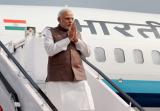Nay Pyi Taw, Nov 11: The 12th ASEAN-India summit kicks off tomorrow with Prime Minister Narendra Modi expected to make a strong pitch to step up engagement with the 10-nation bloc by improving regional connectivity to give a boost to trade and people-to-people contacts.
 Modi arrived in the Myanmarese capital this afternoon by a special Air India plane, starting his 10-day three-nation tour that will also take him to Australia for the G-20 Summit and bilateral talks with his Australian counterpart Tony Abbott and Fijian premier J V Bainimarama.
Modi arrived in the Myanmarese capital this afternoon by a special Air India plane, starting his 10-day three-nation tour that will also take him to Australia for the G-20 Summit and bilateral talks with his Australian counterpart Tony Abbott and Fijian premier J V Bainimarama.
Modi was received by Myanmar Health Minister Than Aung at Nay Pyi Taw International Airport.
"Landed in Nay Pyi Taw, Myanmar to a very warm welcome! Great being in this beautiful country," Modi tweeted after his arrival.
The Prime Minister will attend the India-ASEAN and East Asia summits here.
Asserting that the Association of Southeast Asian Nations (ASEAN) is at the core of India's 'Act East' policy, the Prime Minister said before leaving for Myanmar that he was looking forward to discussing with ASEAN leaders how to take "our relationship to a new level, which will supplement our deepening bilateral ties with each member".
"ASEAN is at the core of our Act East Policy and at the centre of our dream of an Asian century, characterised by cooperation and integration and where India will play a crucial role, " Modi said, adding that ties with ASEAN are "deep rooted".
Modi expressed confidence that these meetings with leaders of ASEAN and East Asian blocs would be fruitful.
Indian officials said New Delhi is keen that the next ASEAN-India five-year plan of action starting 2016 should lay emphasis on enhancing people-to-people contacts, augmenting trade besides reinforcing the strategic and political engagement. The plan will also focus on security architecture in the region.
An ambitious project is underway to develop a 3,200-km highway linking India, Myanmar and Thailand. It was originally envisaged to be completed around 2017 but it is behind schedule and is now expected to be completed in 2018.
India and the 10-nation ASEAN bloc hope to dovetail the connectivity plans with this highway.
Officials said the free trade pact in services and investment between India and the ASEAN is expected to help the bilateral trade touch USD 100 billion by 2015.
The bilateral trade grew 4.6 per cent from USD 68.4 billion in 2011 to USD 71.6 billion in 2012.
ASEAN's exports were valued at USD 43.84 billion and imports from India amounted to USD 27.72 billion in 2012.
The ASEAN community has the third largest population, would be the seventh largest economy in the world and the third fastest growing economic unit this century.
It comprises Brunei, Cambodia, Indonesia, Laos, Malaysia, Myanmar, Singapore, Thailand, the Philippines and Vietnam
Modi will be also participating in the 18-nation EAST Asian Summit(EAS) on Thursday before leaving for Brisbane to attend the G20 Summit.
"At the East Asia Summit, I look forward to discussing with ASEAN and seven global leaders how we can strengthen regional institutions, international norms and regional cooperation in pursuit of peace, stability and prosperity," the Prime Minister said ahead of the deliberations.
The EAS comprises 10 ASEAN nations, Australia, China, India, Japan, New Zealand, South Korea, Russia and the US.
On the sidelines of the international summits in Myanmar, Modi is slated to meet Russian Prime Minister Dmitry Medvedev, South Korean President Park Geun-hye and Singapore President Tony Tan, besides the host President Thein Sein.





Comments
Add new comment